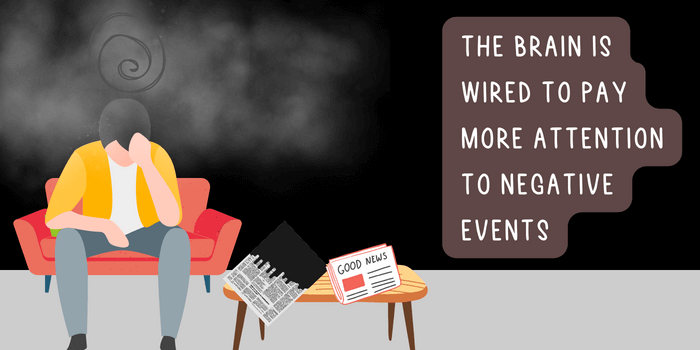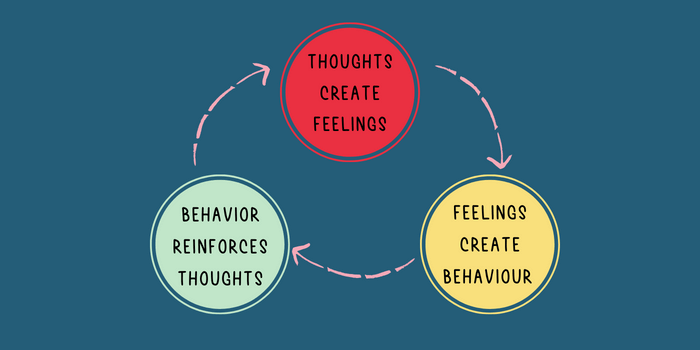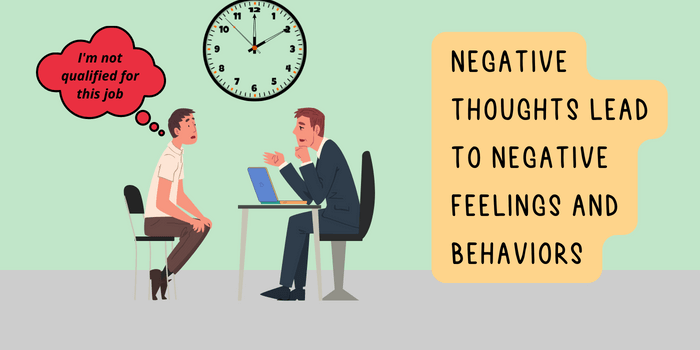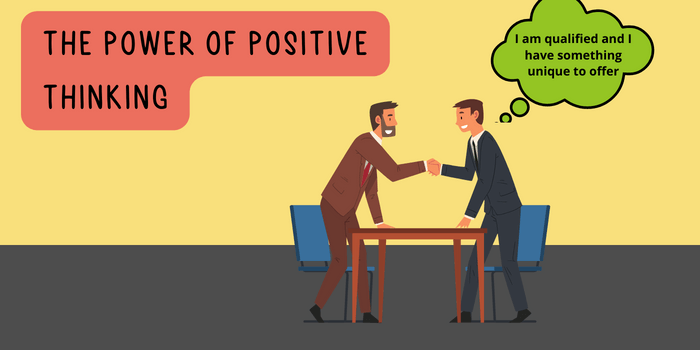Our thoughts are affected by what we experience, during both good times and bad.
It’s normal to feel low and think negative thoughts from time to time. But when negative thinking becomes your predominant nature, then it becomes cause for concern. Excessive negative thinking can trigger a host of mental health problems like anxiety and depression.
To avoid falling into the pattern of negative thinking, let’s first understand why it happens.
The brain is hardwired for negativity
You must have noticed how our brain gets fixated on negative emotions or negative news items. This is because of our innate negativity bias.
Roy Baumeister and John Tierney, co-authors of the book The Power of Bad: How the Negativity Effect Rules Us and How We Can Rule It, say that people learn faster from punishment rather than reward. A bad reputation is easier to acquire and harder to lose than a good reputation. The effects of bad events last much longer than that of good events. Criticism hurts us a lot more than praise pleases us.
Bad is overpoweringly dominant, and stronger than good.
Evolutionarily, it made sense. If a caveman spotted a tiger outside, it paid to skip a day’s meal and hide inside the cave rather than stepping outside to hunt and risk being mauled to death.
We still have this bias towards avoiding negative outcomes. Sometimes this bias is so powerful that we would do anything to avoid the negative outcome, even if it incurs a heavy cost. We are naturally prone to distorted thinking.
Common patterns of negative thinking
An insightful activity you can undertake is to identify the negative thinking patterns that you might be indulging in.
Check the common patterns below and see if you engage in any. The first step to overcome negative thoughts is to recognise them.
Overgeneralization
A cognitive distortion where you make a broad generalization based on just one incident or a small number of incidents, without considering the context or other relevant information.
All-or-nothing thinking
You see things only in black and white, and you don’t allow for any shades of grey. Things are either good or bad, right or wrong. You don’t allow for any middle ground or complexity.
Catastrophizing
You automatically assume that the worst possible outcome will happen, even when the situation doesn’t warrant it. A small problem is a complete disaster. A minor setback is a complete failure. It’s always the worst case scenario that comes to your mind.
Mental filter
A thought pattern where you focus on a single negative aspect of a situation, and ignore all the positive aspects. You might dwell on the one negative thing and blow it out of proportion, while completely ignoring or dismissing the positives.
Emotional reasoning
You base your beliefs and decisions on your emotions, rather than on evidence or logic. You might believe that something is true or right because it feels true or right, and you dismiss evidence or arguments that go against your feelings.
Labelling
Labelling happens when you assign a global, negative label to yourself or someone else, based on a single trait or behavior. You might call yourself or someone else a “loser,” “failure,” or “bad person,” based on a single event or mistake, rather than considering the context or the person’s overall qualities.
Disqualifying the positive
You automatically dismiss or discount any positive experiences, accomplishments, or qualities saying that they don’t count. You might downplay your achievements, or reject compliments or praise that others give you. This can indicate low self esteem and aggressive self criticism.
Jumping to conclusions
You come to a conclusion without sufficient evidence or without considering alternative explanations. There are two types:
- Mind reading, where you assume you know what someone else is thinking without evidence
- Fortune telling, where you predict the future without evidence
Personalization
You blame yourself for negative experiences or situations that are not entirely your fault. You may also attribute other people’s negative behavior or emotions to yourself, even when they are not related to you.
Should statements
You have strict rules or expectations for yourself or others, and you use the word “should” to describe them. You might criticize or blame yourself or others when you don’t meet these high standards or make mistakes.
3 components that make up our experience
Here’s a fundamental concept to understand.
There are 3 components that make up the totality of our emotional experience. They are:
- Thoughts
- Feelings
- Behaviours
The above model is from a CBT (Cognitive Behavioral Therapy) perspective. According to CBT, our thoughts, emotions, and behaviours are interconnected, and by changing our thoughts and beliefs, we can change our emotional experience and the way we act.
Thoughts
We make sense of the world around us through thinking. Our thoughts could be verbal, such as words and sentences, or non-verbal, such as mental images. Thoughts are the ongoing dialogue that we have with ourselves in our minds all through our lives.
Thoughts also play a role in shaping our perception of reality. Our thoughts can sometimes be biased or distorted, and it’s important to recognize and challenge these thought patterns in order to have a more accurate and balanced view of the world.
Feelings
“Feelings,” are not just about our emotional state, but also the physical changes that happen in our body as a result of our emotions. For example, when we’re angry, our face might get red and flushed. And when we’re anxious, our heart might start pounding and we may feel dizzy or nauseous. What we feel physically is the hard-wired manifestation of our emotional state.
Emotions and feelings influence our thoughts, behaviours, and decision-making, and they can also affect our physical health.
Behaviours
Behaviours are the things we do (or don’t do) in response to our thoughts and feelings. For example, if we’re feeling really anxious, we might avoid doing something like giving a presentation. On the other hand, if we’re feeling confident, we might seek out things like speaking up in a meeting or trying something new. So our behaviors are basically just a reflection of our thoughts and feelings – they’re the things we do (or don’t do) in response to what’s going on in our minds.
Understanding and being aware of the relationship between our thoughts, feelings, and behaviors can be helpful in managing and regulating our actions and reactions to the world around us
Diving deeper into how our thoughts impact us
All 3 components – thoughts, feelings, and behaviours – interact with each other to create different emotional states and moods. When you change one component, it triggers a chain reaction that impacts others.
Since we’re concerned with how to stop negative thinking, let’s dive deeper into the “thoughts” component.
Here is a potential real-life illustration of how negative thoughts can impact our feelings and behaviors:
Negative thought
Imagine that you are in a job interview and you have the negative thought “I’m not qualified for this job.” This thought might make you feel anxious, self-conscious, and unsure of yourself. As a result, you stumble over your words, fidget nervously, or avoid making eye contact with the interviewer. These behaviors, in turn, might make the interviewer perceive you as nervous or unsure of yourself, which could negatively impact their impression of you and your chances of getting the job.
In this way, the negative thought (“I’m not qualified for this job”) leads to negative feelings (anxiety, self-consciousness) and negative behaviors (stumbling over your words, fidgeting nervously, avoiding eye contact).
Positive thought
Now imagine that you are in the same job interview and you have the positive thought “I am qualified for this job and I have something unique to offer.” This thought makes you feel confident, engaged, and excited. As a result, you speak clearly and confidently, make strong eye contact, and demonstrate your skills and knowledge. These behaviors, in turn, make the interviewer perceive you as confident and competent, which could positively impact their impression of you and your chances of getting the job.
The positive thought (“I am qualified for this job and I have something unique to offer”) leads to positive feelings (confidence, engagement, excitement) and positive behaviors (speaking clearly and confidently, making eye contact, demonstrating skills and knowledge).
Whether the thought is positive or negative, the resulting feelings and behaviours end up reinforcing the negative or positive thoughts, thus perpetuating the feedback loop.
Overcoming negative thinking
When it becomes deeply ingrained and habitual, negative thinking can be a difficult and harmful pattern to break. It’s important to recognize and address negative thoughts at all levels – the thoughts themselves, the emotions they trigger, and the behaviors they lead to.
In the next article, we’ll go over some helpful ways and strategies to stop negative thoughts and cultivate a more positive outlook.
Remember, it takes time and practice to break negative thought patterns, but with effort and support, it is possible to develop more positive and healthy ways of thinking. Hang in there!




